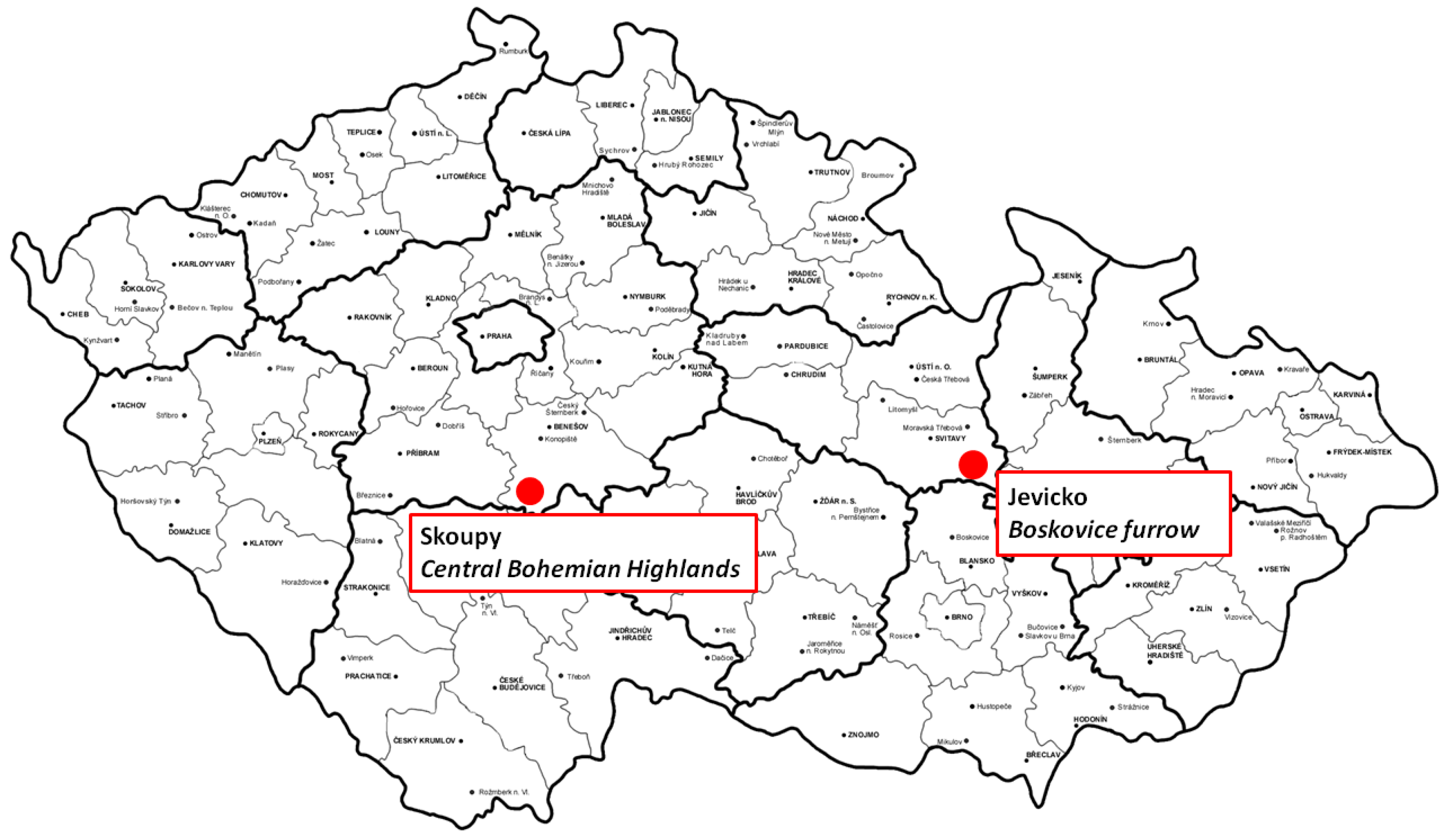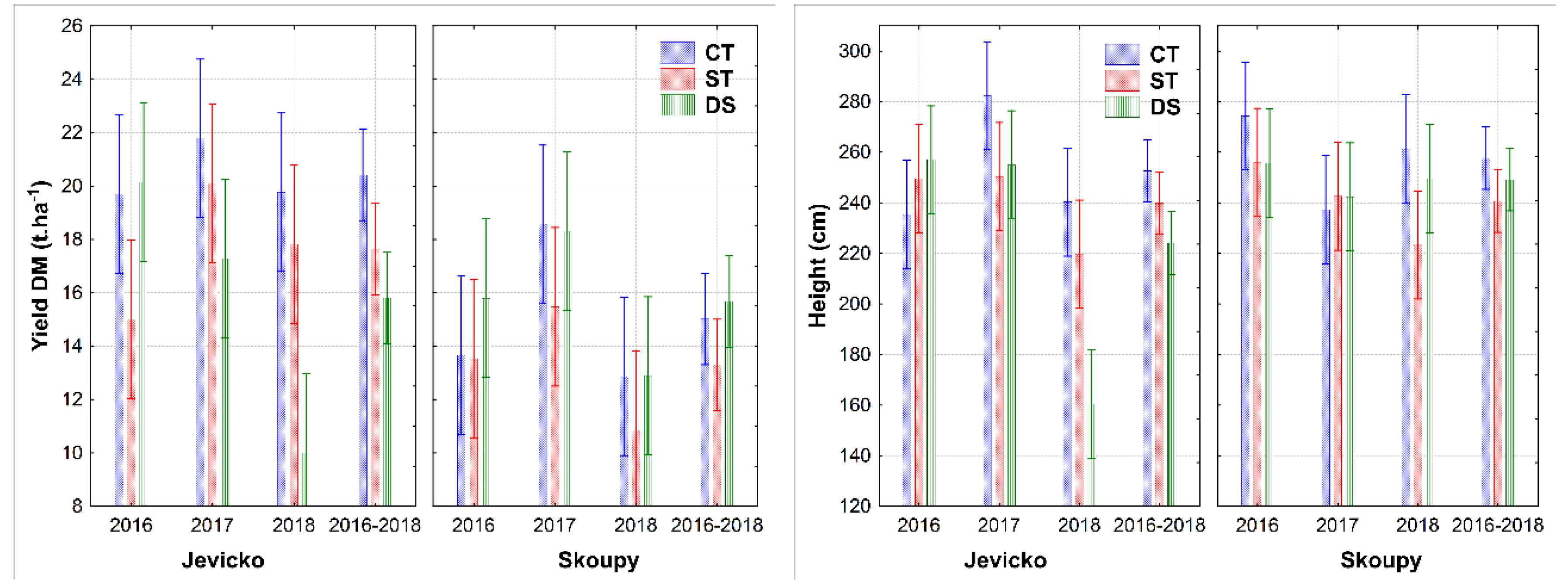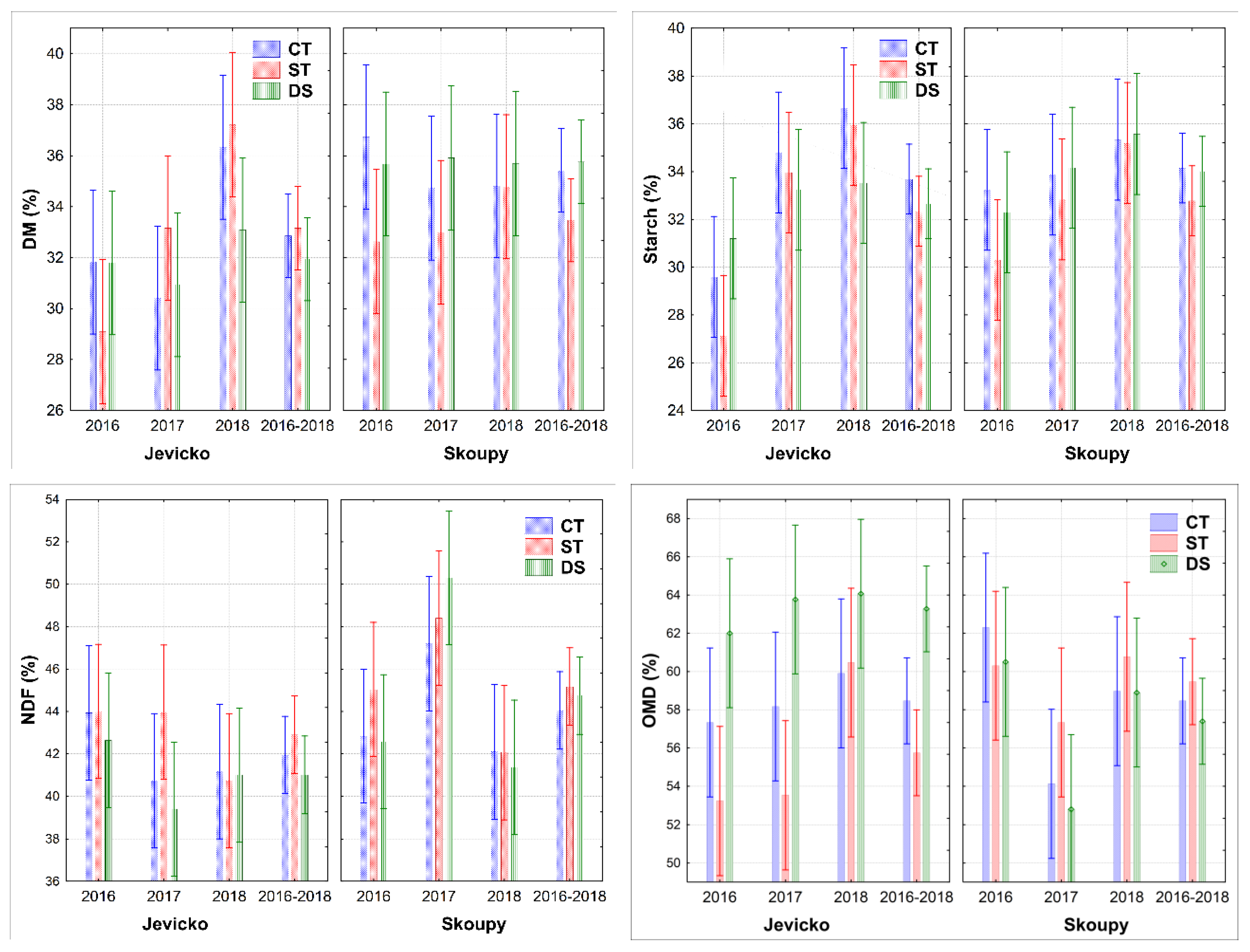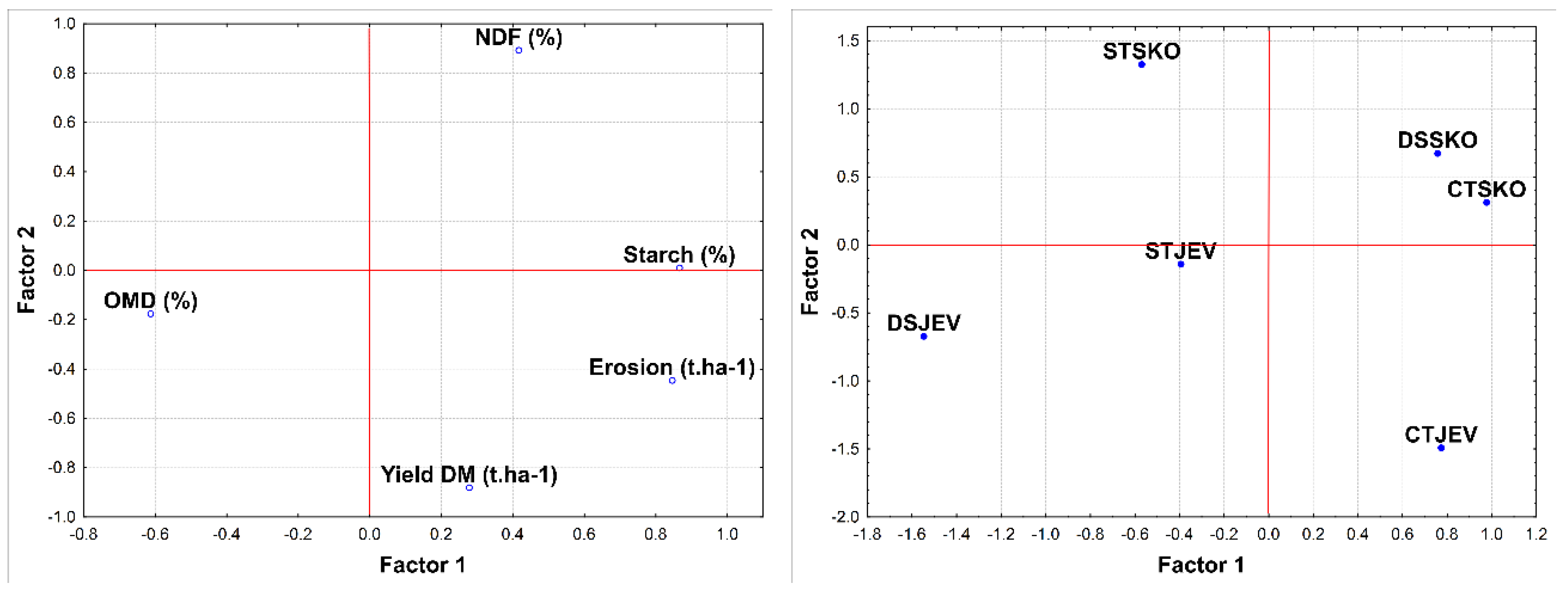Water Erosion Reduction Using Different Soil Tillage Approaches for Maize (Zea mays L.) in the Czech Republic
Abstract
:1. Introduction
2. Materials and Methods
2.1. Site Description
2.2. Experimental Design
2.3. Yield and Forage Quality
2.4. Soil Erosion Analysis
2.5. Statistical Analysis
3. Results
3.1. Yield
3.2. Forage Quality
3.3. Soil Erosion and Surface Runoff
3.4. Multi-Criteria Evaluation
4. Discussion
5. Conclusions
Author Contributions
Funding
Acknowledgments
Conflicts of Interest
References
- IPCC. IPCC Special Report on Renewable Energy Sources and Climate Change Mitigation. Prepared by Working Group III of the Intergovernmental Panel on Climate Change; Cambridge University Press: Cambridge, UK; New York, NY, USA, 2011. [Google Scholar]
- IPCC. Climate Change 2014: Mitigation of Climate Change. Contribution of Working Group III to the Fifth Assessment Report of the Intergovernmental Panel on Climate Change; Cambridge University Press: Cambridge, UK; New York, NY, USA, 2014. [Google Scholar]
- Zimolka, J. Kukuřice—Hlavní a Alternativní Užitkové Směry; 1. vyd.; Profi Press: Praha, Czech Republic, 2008; ISBN 978-80-86726-31-1 CN—UK-80821/1. [Google Scholar]
- Klopfenstein, T.J.; Erickson, G.E.; Berger, L.L. Maize is a critically important source of food, feed, energy and forage in the USA. Field Crop. Res. 2013, 153, 5–11. [Google Scholar] [CrossRef]
- Yu, C.-L.; Hui, D.; Deng, Q.; Wang, J.; Reddy, K.C.; Dennis, S. Responses of corn physiology and yield to six agricultural practices over three years in middle Tennessee. Sci. Rep. 2016, 6, 1–9. [Google Scholar] [CrossRef] [PubMed] [Green Version]
- Vogel, E.; Deumlich, D.; Kaupenjohann, M. Bioenergy maize and soil erosion—Risk assessment and erosion control concepts. Geoderma 2016, 261, 80–92. [Google Scholar] [CrossRef]
- Chalise, D.; Kumar, L.; Sharma, R.; Kristiansen, P. Assessing the impacts of tillage and mulch on soil erosion and corn yield. Agronomy 2020, 10, 63. [Google Scholar] [CrossRef] [Green Version]
- Jarvis, A.; Lau, C.; Cook, S.; Wollenberg, E.; Hansen, J.; Bonilla, O.; Challinor, A. An integrated adaptation and mitigation framework for developing agricultural research: Synergies and trade-offs. Exp. Agric. 2011, 47, 185–203. [Google Scholar] [CrossRef] [Green Version]
- Knox, J.; Hess, T.; Daccache, A.; Wheeler, T. Climate change impacts on crop productivity in Africa and South Asia. Environ. Res. Lett. 2012, 7. [Google Scholar] [CrossRef]
- Rosenzweig, C.; Elliott, J.; Deryng, D.; Ruane, A.C.; Müller, C.; Arneth, A.; Boote, K.J.; Folberth, C.; Glotter, M.; Khabarov, N.; et al. Assessing agricultural risks of climate change in the 21st century in a global gridded crop model intercomparison. Proc. Natl. Acad. Sci. USA 2014, 111, 3268–3273. [Google Scholar] [CrossRef] [PubMed] [Green Version]
- Steenwerth, K.L.; Reynolds, M.P.; Sandoval Solis, S.; Sischo, W.M.; Lubell, M.N.; Msangi, S.; Prabhu, R.; Springborn, M.; Wollenberg, E.K.; Jarvis, L.S.; et al. Climate-smart agriculture global research agenda: Scientific basis for action [electronic resource]. Agric. Food Secur. 2014, 3, 56. [Google Scholar] [CrossRef] [Green Version]
- Lone, B.; Qayoom, S.; Singh, P.; Dar, Z.; Kumar, S.; Dar, N.; Fayaz, A.; Ahmad, N.; Bhat, M.; Singh, G. Climate Change and Its Impact on Crop Productivity. Br. J. Appl. Sci. Technol. 2017, 21, 1–15. [Google Scholar] [CrossRef] [Green Version]
- Blanco, M.; Ramos, F.; Van Doorslaer, B.; Martínez, P.; Fumagalli, D.; Ceglar, A.; Fernández, F.J. Climate change impacts on EU agriculture: A regionalized perspective taking into account market-driven adjustments. Agric. Syst. 2017, 156, 52–66. [Google Scholar] [CrossRef]
- Brevik, E.C.; Cerdà, A.; Mataix-Solera, J.; Pereg, L.; Quinton, J.N.; Six, J.; Van Oost, K. The interdisciplinary nature of SOIL. Soil 2015, 1, 117–129. [Google Scholar] [CrossRef] [Green Version]
- Menšík, L.; Hlisnikovský, L.; Pospíšilová, L.; Kunzová, E. The effect of application of organic manures and mineral fertilizers on the state of soil organic matter and nutrients in the long-term field experiment. J. Soils Sediments 2018, 18, 2813–2822. [Google Scholar] [CrossRef]
- Menšík, L.; Hlisnikovský, L.; Kunzová, E. The State of the Soil Organic Matter and Nutrients in the Long-Term Field Experiments with Application of Organic and Mineral Fertilizers in Different Soil-Climate Conditions in the View of Expecting Climate Change. In Organic Fertilizers—History, Production and Applications; Larramendy, M.L., Soloneski, S., Eds.; IntechOpen: London, UK, 2019; pp. 23–42. [Google Scholar]
- Žížala, D.; Zádorová, T.; Kapička, J. Assessment of soil degradation by erosion based on analysis of soil properties using aerial hyperspectral images and ancillary data, Czech Republic. Remote Sens. 2017, 9, 28. [Google Scholar] [CrossRef] [Green Version]
- Durán Zuazo, V.H.; Rodríguez Pleguezuelo, C.R. Soil-erosion and runoff prevention by plant covers. A review. Agron. Sustain. Dev. 2008, 28, 65–86. [Google Scholar] [CrossRef] [Green Version]
- Guo, M.; Zhang, T.; Li, Z.; Xu, G. Investigation of Runoff and Sediment Yields Under Different Crop and Tillage Conditions by Field Artificial Rainfall Experiments. Water 2019, 11, 1019. [Google Scholar] [CrossRef] [Green Version]
- Šarapatka, B.; Bednář, M. Analysis of Soil Degradation in the Czech Republic: GIS Approach. Soil Water Res. 2010, 2010, 108–112. [Google Scholar] [CrossRef] [Green Version]
- Brant, V.; Kroulík, M.; Pivec, J.; Zábranský, P.; Hakl, J.; Holec, J.; Kvíz, Z.; Procházka, L. Splash erosion in maize crops under conservation management in combination with shallow strip-Tillage before Sowing. Soil Water Res. 2017, 12, 106–116. [Google Scholar] [CrossRef] [Green Version]
- Poláková, J.; Janků, J.; Nocarová, M. Soil erosion, regulatory aspects and farmer responsibility: Assessing cadastral data. Acta Agric. Scand. Sect. B Soil Plant Sci. 2018, 68, 709–718. [Google Scholar] [CrossRef]
- Menšík, L.; Kincl, D.; Nerušil, P.; Srbek, J.; Kabelka, D.; Herout, M.; Jurka, M.; Šedek, A.; Horký, T.; Vach, M. Pěstování Kukuřice seté Půdoochrannými Technologiemi. Příkladová Studie Boskovická Brázda a Středočeská Pahorkatina; Výzkumný Ústav Rostlinné Výroby, v.v.i.: Praha 6—Ruzyně, Praha, Czech Republic, 2018; ISBN 978-80-7427-288-2. [Google Scholar]
- Kubát, J.; Lipavský, J. Evaluation of Organic Matter Content in Arable Soils in the Czech Republic. In Crop Science and Land Use for Food and Bioenergy; Behl, R.K., Merbach, W., Meliczek, H., Kaetsch, C., Eds.; Agrobios (International): Jodhpur, India, 2010; pp. 245–251. [Google Scholar]
- Šarapatka, B.; Bednář, M. Assessment of Potential Soil Degradation on Agricultural Land in the Czech Republic. J. Environ. Qual. 2015, 44, 154. [Google Scholar] [CrossRef]
- Novotný, I.; Žížala, D.; Kapička, J.; Beitlerová, H.; Mistr, M.; Kristenová, H.; Papaj, V. Adjusting the CPmaxfactor in the Universal Soil Loss Equation (USLE): Areas in need of soil erosion protection in the Czech Republic. J. Maps 2016, 12, 58–62. [Google Scholar] [CrossRef] [Green Version]
- Janeček, M.; Dostál, T.; Kozlovsky-Dufková, J.; Dumbrovský, M.; Hůla, J.; Kadlec, V.; Konečná, J.; Kovář, P.; Krása, J.; Kubátová, E. Ochrana Zemědělské Půdy Před Erozí/Protection of Agricultural Soils from the Soil Erosion/; Powerprint: Praha, Czech Republic, 2012. [Google Scholar]
- Renard, K.G.; Foster, G.R.; Weesies, G.A.; Porter, J.P. RUSLE: Revised universal soil loss equation. J. Soil Water Conserv. 1991, 46, 30–33. [Google Scholar]
- Panagos, P.; Borrelli, P.; Meusburger, K.; Alewell, C.; Lugato, E.; Montanarella, L. Estimating the soil erosion cover-management factor at the European scale. Land Use Policy 2015, 48, 38–50. [Google Scholar] [CrossRef]
- Hůla, J.; Kovaříček, P.; Novák, P.; Vlášková, M. Surface Water Runoff and Soil Loss in Maize Cultivation. In Proceedings of the 6th International Conference on Trends in Agricultural Engineering, Prague, Czech Republic, 7–9 September 2016; pp. 201–205. [Google Scholar]
- Procházková, E.; Kincl, D.; Kabelka, D.; Vopravil, J.; Nerušil, P.; Menšík, L.; Barták, V. The impact of the conservation tillage “maize into grass cover” on reducing the soil loss due to erosion. Soil Water Res. 2020, 15, 158–165. [Google Scholar] [CrossRef]
- Choudhary, M.A.; Lal, R.; Dick, W.A. Long-term tillage effects on runoff and soil erosion under simulated rainfall for a central Ohio soil. Soil Tillage Res. 1997, 42, 175–184. [Google Scholar] [CrossRef]
- Bispo, D.F.A.; Silva, M.L.N.; Pontes, L.M.H.; Guimarães, D.V.; De Sá E Melo Marques, J.J.G.; Curi, N. Soil, water, nutrients and soil organic matter losses by water erosion as a function of soil management in the Posses sub-watershed, Extrema, Minas Gerais, Brazil. Semin. Cienc. Agrar. 2017, 38, 1813–1824. [Google Scholar] [CrossRef] [Green Version]
- Kisic, I.; Bogunovic, I.; Zgorelec, Z.; Bilandzija, D. Effects of soil erosion by water under different tillage treatments on distribution of soil chemical parameters. Soil Water Res. 2018, 13, 36–43. [Google Scholar] [CrossRef] [Green Version]
- Potop, V.; Türkott, L.; Kožnarová, V.; Možný, M. Drought episodes in the Czech Republic and their potential effects in agriculture. Theor. Appl. Climatol. 2010, 99, 373–388. [Google Scholar] [CrossRef] [Green Version]
- Durdu, Ö.F. Evaluation of climate change effects on future corn (Zea mays L.) yield in western Turkey. Int. J. Climatol. 2013, 33, 444–456. [Google Scholar] [CrossRef]
- Ramirez-Cabral, N.Y.Z.; Kumar, L.; Shabani, F. Global alterations in areas of suitability for maize production from climate change and using a mechanistic species distribution model (CLIMEX). Sci. Rep. 2017, 7, 5910. [Google Scholar] [CrossRef]
- Lal, R. Mechanized tillage systems effects on soil erosion from an alfisol in watersheds cropped to maize. Soil Tillage Res. 1984, 4, 349–360. [Google Scholar] [CrossRef]
- Vyn, T.J.; Raimbault, B.A. Evaluation of strip tillage systems for corn production in Ontario. Soil Tillage Res. 1992, 23, 163–176. [Google Scholar] [CrossRef]
- Cannell, R.Q.; Hawes, J.D. Trends in tillage practices in relation to sustainable crop production with special reference to temperate climates. Soil Tillage Res. 1994, 30, 245–282. [Google Scholar] [CrossRef]
- Basic, F.; Kisic, I.; Mesic, M.; Nestroy, O.; Butorac, A. Tillage and crop management effects on soil erosion in central Croatia. Soil Tillage Res. 2004, 78, 197–206. [Google Scholar] [CrossRef]
- Prasuhn, V. On-farm effects of tillage and crops on soil erosion measured over 10 years in Switzerland. Soil Tillage Res. 2012, 120, 137–146. [Google Scholar] [CrossRef]
- Ryken, N.; Vanden Nest, T.; Al-Barri, B.; Blake, W.; Taylor, A.; Bodé, S.; Ruysschaert, G.; Boeckx, P.; Verdoodt, A. Soil erosion rates under different tillage practices in central Belgium: New perspectives from a combined approach of rainfall simulations and7Be measurements. Soil Tillage Res. 2018, 179, 29–37. [Google Scholar] [CrossRef]
- Buchner, W.; Köller, K. Intergrierte Bodenbearbeitung; Ulmer Verlag: Stuttgart, Germany, 1990. [Google Scholar]
- Claassen, R.; Bowman, M.; McFadden, J.; Smith, D.; Wallander, S. Tillage Intensity and Conservation Cropping in the United States, EIB-197; U.S. Department of Agriculture, Economic Research Service: Washington, DC, USA, 2018. [Google Scholar]
- Mal, P.; Schmitz, M.; Hesse, J.W. Economic and Environmental Effects of Conservation Tillage with Glyphosate Use: A Case Study of Germany. Outlooks Pest Manag. 2015, 26, 24–27. [Google Scholar] [CrossRef]
- Wade, T.; Claassen, R. Modeling No-Till Adoption by Corn and Soybean Producers: Insights into Sustained Adoption. J. Agric. Appl. Econ. 2017, 49, 186–210. [Google Scholar] [CrossRef] [Green Version]
- Zhou, X.; Al-kaisi, M.; Helmers, M.J. Cost effectiveness of conservation practices in controlling water erosion in Iowa. Soil Tillage Res. 2009, 106, 71–78. [Google Scholar] [CrossRef]
- Benincasa, P.; Zorzi, A.; Panella, F.; Tosti, G.; Trevini, M. Strip tillage and sowing: Is precision planting indispensable in silage maize? Int. J. Plant Prod. 2017, 11, 577–588. [Google Scholar] [CrossRef]
- Morrison, J.E. Strip tillage for “no-till” row crop production. Appl. Eng. Agric. 2002, 18, 277–284. [Google Scholar] [CrossRef]
- Vetsch, J.A.; Randall, G.W.; Lamb, J.A. Corn and Soybean Production as Affected by Tillage Systems. Agron. J. 2007, 99, 952–959. [Google Scholar] [CrossRef]
- Holland, J.M. The environmental consequences of adopting conservation tillage in Europe: Reviewing the evidence. Agric. Ecosyst. Environ. Environ. 2004, 103, 1–25. [Google Scholar] [CrossRef]
- Leys, A.; Govers, G.; Gillijns, K.; Poesen, J. Conservation tillage on loamy soils: Explaining the variability in interrill runoff and erosion reduction. Eur. J. Soil Sci. 2007, 58, 1425–1436. [Google Scholar] [CrossRef]
- Scopel, E.; Findeling, A.; Guerra, E.C.; Corbeels, M. Impact of direct sowing mulch-based cropping systems on soil carbon, soil erosion and maize yield. Agron. Sustain. Dev. 2005, 25, 425–432. [Google Scholar] [CrossRef] [Green Version]
- Garibay, S.V.; Stamp, P.; Ammon, H.U.; Feil, B. Yield and quality components of silage maize in killed and live cover crop sods. Eur. J. Agron. 1997, 6, 179–190. [Google Scholar] [CrossRef]
- Gruber, S.; Pekrun, C.; Möhring, J.; Claupein, W. Long-term yield and weed response to conservation and stubble tillage in SW Germany. Soil Tillage Res. 2012, 121, 49–56. [Google Scholar] [CrossRef]
- IUSS Working Group WRB. World Reference Base for Soil Resources 2014, Update 2015 International Soil Classification System for Naming Soils and Creating Legends for Soil Maps; World Soil Resources Reports No. 106; FAO: Rome, Italy, 2015. [Google Scholar]
- Old, C.A.; Oltjen, J.W.; Miller, J.R.; Ohanesian, N.; Hinders, R.G.; Vogt, W.; Sapienza, D.A. Reliability of in vivo, in vitro, in silico, and near infrared estimates of pure stand alfalfa hay quality: Component degradability and metabolizability of energy. Prof. Anim. Sci. 2016, 32, 470–483. [Google Scholar] [CrossRef]
- Bell, M.J.; Mereu, L.; Davis, J. The Use of Mobile Near-Infrared Spectroscopy for Real-Time Pasture Management. Front. Sustain. Food Syst. 2018, 2, 76. [Google Scholar] [CrossRef] [Green Version]
- Weld, K.A.; Armentano, L.E. Feeding high oleic acid soybeans in place of conventional soybeans increases milk fat concentration. J. Dairy Sci. 2018, 101, 9768–9776. [Google Scholar] [CrossRef] [Green Version]
- Christiansen, J.E. Irrigation by Sprinkling; University of California—Agricultural Experiment Station Bulletin; University of California: Berkeley, CA, USA, 1942; Volume 670, p. 124. [Google Scholar]
- Meloun, M.; Militký, J. Statistical Data Analysis, A Practical Guide with 1250 Exercises and Answer key on CD; Woodhead Publishing India: New Delhi, India, 2011; ISBN 978-93-80308-11-1. [Google Scholar]
- 334/1992 Coll. CZECH REPUBLIC. Czech National Council Act No. 334/1992 Coll. On the Protection of Agricultural Land Fund. In The Collection of Laws; Czech National Council: Prague, Czech Republic, 1992; Volume 68, Issue 334. [Google Scholar]
- Boerjan, W.; Ralph, J.; Baucher, M. Lignin biosynthesis. Annu. Rev. Plant Biol. 2003, 54, 519–546. [Google Scholar] [CrossRef]
- Torres, I.F.; Bastida, F.; Hernández, T.; Bombach, P.; Richnow, H.H.; García, C. The role of lignin and cellulose in the carbon-cycling of degraded soils under semiarid climate and their relation to microbial biomass. Soil Biol. Biochem. 2014, 75, 152–160. [Google Scholar] [CrossRef]
- Findeling, A.; Ruy, S.; Scopel, E. Modeling the effects of a partial residue mulch on runoff using a physically based approach. J. Hydrol. 2003, 275, 49–66. [Google Scholar] [CrossRef]
- Schiettecatte, W.; Verbist, K.; Gabriels, D. Assessment of detachment and sediment transport capacity of runoff by field experiments on a silt loam soil. Earth Surf. Process. Landf. 2008, 33, 1302–1314. [Google Scholar] [CrossRef]
- Armand, R.; Bockstaller, C.; Auzet, A.-V.; Van Dijk, P. Runoff generation related to intra-field soil surface characteristics variability: Application to conservation tillage context. Soil Tillage Res. 2009, 102, 27–37. [Google Scholar] [CrossRef]
- Moldenhauer, W.C.; Langdale, G.W.; Frye, W.; McCool, D.K.; Papendick, R.I.; Smika, D.E.; Fryrear, D.W. Conservation tillage for erosion control. J. Soil Water Conserv. 1983, 38, 144–151. [Google Scholar]
- Roger-Estrade, J.; Labreuche, J.; Richard, G. Effets de l’adoption des techniques culturales sans labour (TCSL) sur l’état physique des sols: Conséquences sur la protection contre l’érosion hydrique en milieu tempéré. Cah. Agric. 2011, 20, 186–193. [Google Scholar] [CrossRef]
- CHMI Mimořádně Teplý Půlrok. Takové Období Meteorologové Nezaznamenali 243 Let. /Extremely Warm Half a Year. Such a Period of Meteorologists Did Not Record 243 Years. Available online: https://www.novinky.cz/domaci/clanek/mimoradne-teply-pulrok-takove-obdobi-meteorologove-nezaznamenali-243-let-40209881 (accessed on 15 September 2020).
- Nerusil, P.; Mensik, L.; Vach, M.; Mlcochova, M.; Kincl, D. The use of soil-conservation strip-tillage technologies for the establishment of silage corn in forage crops on arable land /in Czech/. Uroda 2018, 66, 339–343. [Google Scholar]







| Parameter | Factor Weights | Contribution of Factors | |||
|---|---|---|---|---|---|
| Factor 1 | Factor 2 | Factor 1 | Factor 2 | Communality | |
| Yield DM (t.ha−1) | 0.2784 | −0.8812 | 0.0775 | 0.8540 | 0.8797 |
| Starch (%) | 0.8662 | 0.0097 | 0.7503 | 0.7504 | 0.8579 |
| NDF (%) | 0.4171 | 0.8921 | 0.1740 | 0.9698 | 0.8868 |
| OMD (%) | −0.6124 | −0.1766 | 0.3750 | 0.4062 | 0.7869 |
| Erosion (t.ha−1) | 0.8464 | −0.4464 | 0.7165 | 0.9157 | 0.8823 |
© 2020 by the authors. Licensee MDPI, Basel, Switzerland. This article is an open access article distributed under the terms and conditions of the Creative Commons Attribution (CC BY) license (http://creativecommons.org/licenses/by/4.0/).
Share and Cite
Menšík, L.; Kincl, D.; Nerušil, P.; Srbek, J.; Hlisnikovský, L.; Smutný, V. Water Erosion Reduction Using Different Soil Tillage Approaches for Maize (Zea mays L.) in the Czech Republic. Land 2020, 9, 358. https://doi.org/10.3390/land9100358
Menšík L, Kincl D, Nerušil P, Srbek J, Hlisnikovský L, Smutný V. Water Erosion Reduction Using Different Soil Tillage Approaches for Maize (Zea mays L.) in the Czech Republic. Land. 2020; 9(10):358. https://doi.org/10.3390/land9100358
Chicago/Turabian StyleMenšík, Ladislav, David Kincl, Pavel Nerušil, Jan Srbek, Lukáš Hlisnikovský, and Vladimír Smutný. 2020. "Water Erosion Reduction Using Different Soil Tillage Approaches for Maize (Zea mays L.) in the Czech Republic" Land 9, no. 10: 358. https://doi.org/10.3390/land9100358





